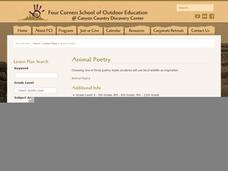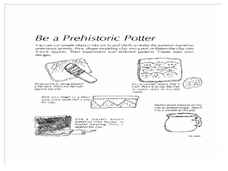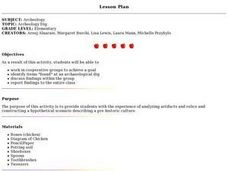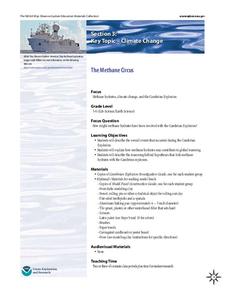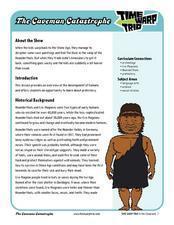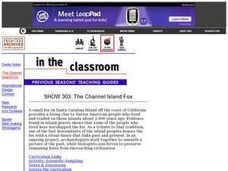Curated OER
Animal Poetry
Fourth graders write poems that use local wildlife as their inspiration. After a class discussion which produces a list of wildlife that pupils have seen in their town, a review of three types of poetry ensues. They look at how haiku,...
Curated OER
Archaeology and Prehistoric Native Americans
Young scholars study the terms paleontology and archaeology and examine how they can help us learn about prehistoric Native Iowans. For this archaeology lesson students discuss these terms and view a video on Native Americans.
Curated OER
Relative Dating in Archaeology
Students create a timeline that explains how ancient cultures used artifacts. In this Relative Dating in Archaeology lesson, students examine artifacts and draw conclusions about their origins. Then students analyze antiquated objects or...
Curated OER
"Archeology Dig"
Students simulate archaeologists as they dig through a bag with found items in order to arrive at conclusions about the people they are studying.
Curated OER
Basics of Archaeology
Students identify what and how to complete an Archaeological excavation is conducted. They identify the transition from one layer to the next more easily if the colors of the layers are different. When creating a dig, the teacher...
American Museum of Natural History
Ask a Scientist About Mummies
Many are aware of the mummies found in the tombs of Egypt. But in addition to the mummified bodies of the ancient pharaohs like King Tut, archaeologists also found cat mummies, dog mummies, and alligator mummies. In a video interview,...
TED-Ed
Did the Amazons Really Exist?
Who were the warriors most feared by the Egyptians, Greeks, Persians Central Asians, and Chinese? The mighty women called Amazons, that’s who. Secondary viewers learn that the understanding of the Amazons, who were originally assumed to...
Curated OER
Unearthing the Past
Students analyze artifacts from an early society to determine information relating to daily life in that society. They consider which artifacts from our society would be most valuable to future archeologists.
Curated OER
Archeology Dig
Learners look into a bag of artifacts as a group and draw conclusions on what they find. For this archaeology lesson plan, students draw a picture of the settlement represented by these items.
Channel Islands Film
Arlington Springs Man: Lesson Plan 4
West of the West's documentary Arlington Springs Man introduces viewers to the remarkable finds on Santa Rosa Island. Archaeologist have discovered on this small island that is part of the Channel island chain, human and pygmy mammoth...
Curated OER
Experimental Archaeology: Making Cordage
Young scholars make a cordage and use an activity sheet to experience a skill that ancient Native American in North Carolina neded for everyday life.
NOAA
The Methane Circus
Step right up! An engaging research-centered lesson, the third in a series of six, has young archaeologists study the amazing animals of the Cambrian explosion. Working in groups, they profile a breathtaking and odd creature and learn...
Curated OER
Sand & Water: Shape Search
Learners act as amateur archaeologists as they participate in their own "dig" to explore and record unusual shapes. In this shape exploration lesson, students use trowels and shovels to dig, and learn to sift the dirt with screens to...
Be Smart
A Mammoth Undertaking: The Science of De-Extinction!
If scientists could use biotechnology to bring back extinct species, should it? A thought-provoking video explores the technical and ethical considerations of this question as part of a larger biology playlist. It explains what would be...
TED-Ed
The Hidden Worlds within Natural History Museums
Behind the closed doors of natural history museums lies a hidden world of scientific research and discovery that goes unseen for visitors. Follow along as this short video explores different scientific mysteries that have been solved...
Time Warp Trio
The Caveman Catastrophe
Young archaeologists study the development of human history, and work in groups to create a timeline that traces the development of humans. Additionally, the groups utilize a very clever graphic organizer embedded in the plan in order to...
Curated OER
Archaeology 2500: Texano Weapons
Young scholars listen to oral story describing mystery artifact, work in groups to write descriptive report of artifact, and creatively form hypothesis based purely on misinterpretation. Students then explore and discuss difficulty of...
TED-Ed
What Causes Cavities?
How do cavities form, and how can you avoid them? An amusing animated video demonstrates how microbes living in our mouths attack the surface enamel of our teeth and, if untreated, the subsurface levels as well.
American Museum of Natural History
Ask a Scientist About T. Rex
With its small arms and giant body, many children are fascinated by the T-Rex. Use the online resource to learn about the characteristics of the T-Rex and how scientists study the extinct species. A paleontologist answers a series of...
Curated OER
Working With Animals
Second graders study careers that involve animal care such as veterinarians, zookeepers and archeologists. They create a collage of animal drawings related to the careers.
Curated OER
SHOW 303: The Channel Island Fox
Pupils explore how archaeologists and other scientists use different clues to piece together a picture of the past. Students perform activities that allow them to conduct three types of scientific research. They discuss their...
Curated OER
Taming the Wild Aurochs
Fourth graders assess the development of animal husbandry, outline it in detail as well as arrange the steps in sequential order. In addition, they discuss how certain animals came to be domesticated, concentrate to research on one of...
Curated OER
Big Bones, Little Bones
Students investigate archeology. In this archeology lesson, students research the process of excavation. Students participate in a mock-excavation and sort objects by physical properties.
TED-Ed
What Can You Learn From Ancient Skeletons?
Skeletons may not be able to speak, but they can still tell us a lot. High schoolers watch a short video about the ways biological anthropologists can use a skeleton's bone structure to determine age, gender, place of birth, and social...


